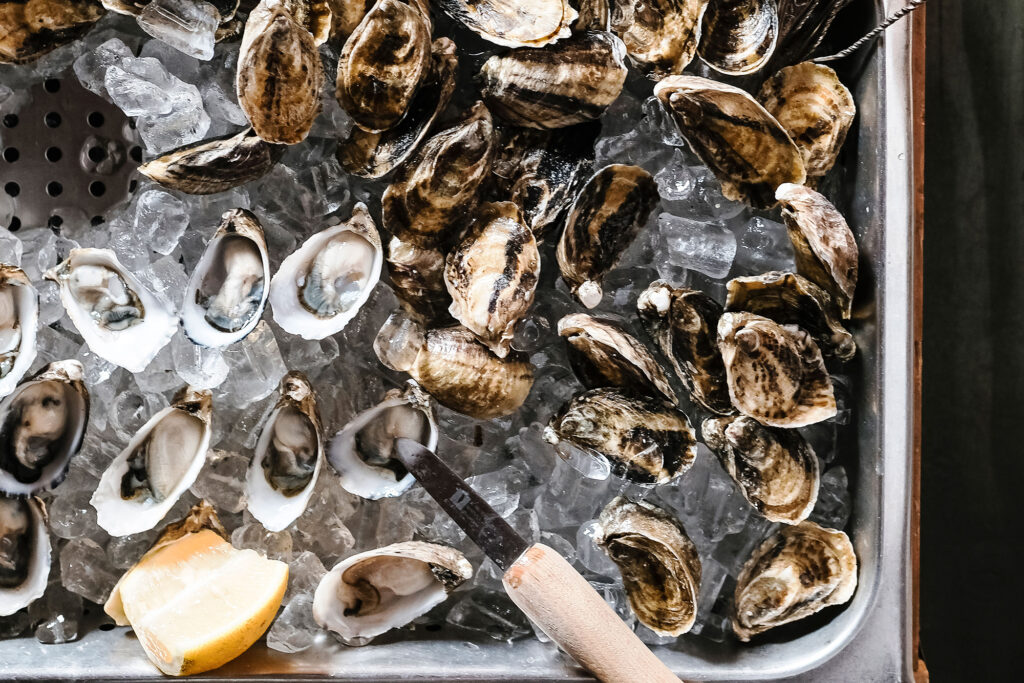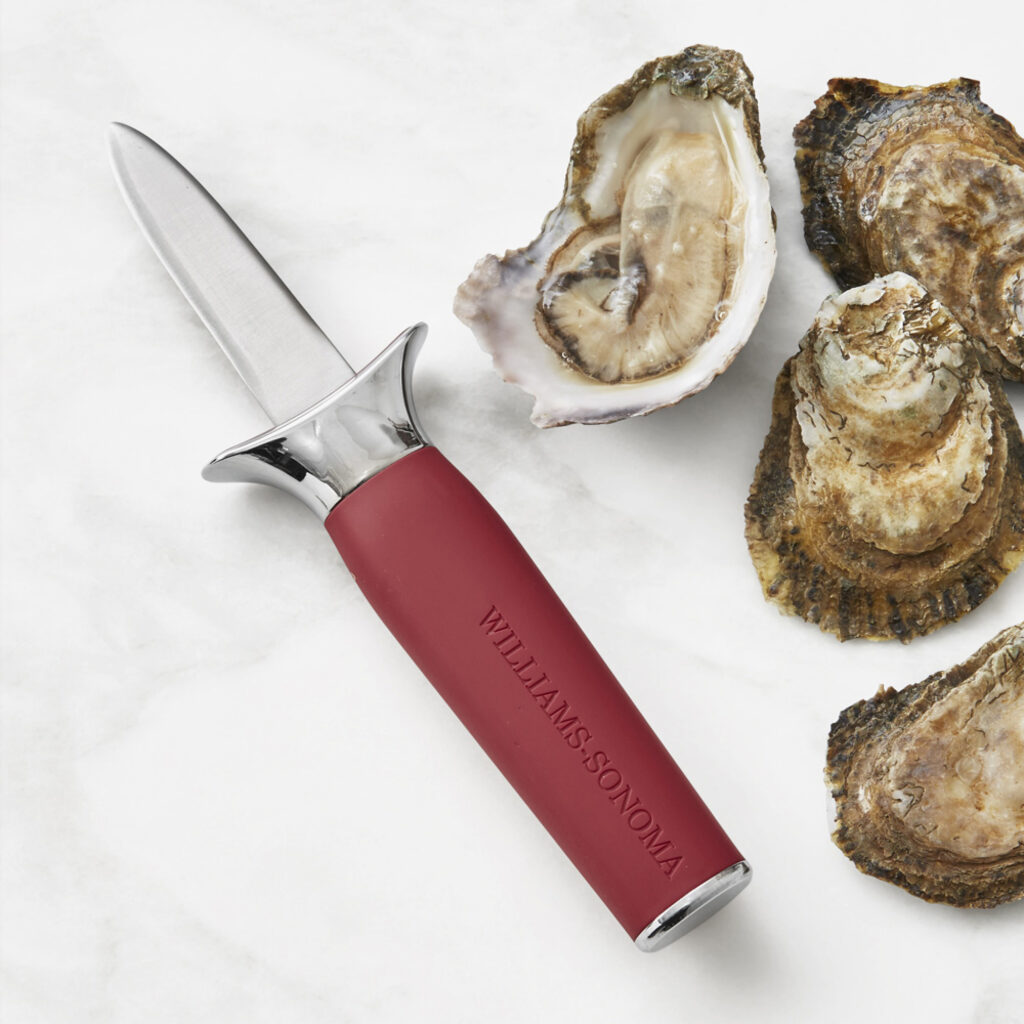
How to Prepare Oysters at Home Like a Michelin-Starred Chef
It’s not as intimidating as you think.

Preparing and eating oysters at home can seem intimidating. In fact, probably a lot of oyster lovers out there would rather just get a dozen at a restaurant than try their hand at shucking. But, enjoying the bivalves at home can be easier than you think, especially if you’re armed with the expertise.
We tapped Los Angeles-based experts, Chef-Owner Michael Cimarusti of Michelin-starred Providence and Connie & Ted’s and Executive Chef Sam Baxter of Connie & Ted’s, for their best tips and tricks. Here’s what they had to say:

Thomas J. Story
How to Buy Oysters
Where to Buy Oysters
Both chefs say that there are a lot of online sources that will ship oysters overnight—Cimarusti highlights Glidden Point, and Baxter recommends Taylor Shellfish in the Pacific Northwest and Island Creek in Massachusetts.
If you want to purchase in-person, check Whole Foods or seafood markets. For those of us in Los Angeles, Baxter suggests checking out the Hollywood Farmers Market on Sunday mornings (one of Connie and Ted’s local purveyors has a stand there) or Santa Monica Seafood or Eataly.

Robiee Ziegler
How to Shop for Oysters
“When shopping for oysters in person, the first thing to notice is whether or not the oysters are being stored cup side down, and on ice. A cold oyster is a happy oyster,” Baxter says. “You want to make sure the oysters have a harvest tag with a date preferably no older than four days or so. But tags are just paper, and could potentially be moved around. The most important thing to check for, is that the oysters you are purchasing are tightly closed and feel heavy for their size. If an oyster is even slightly agape or has a hollow sound when tapped against another oyster, it should not be purchased.”
Some things you might want to ask the purveyor or seller is when were they harvested, where are they from, are they East or West Coast, their salinity level, and their general flavor profile.
Make sure your put a cooler in your trunk before you go shopping. “Oysters like to be cold, but they don’t like to be submerged in fresh water,” Baxter says. “A small cooler with ice packs is a good option for transporting them. If you don’t have that option, and you need to use ice (cubes or crushed), make sure the oysters are suspended out of any melting ice.”

Alexander Spatari/Getty Images
What Are the Different Types of Oysters?
The particular species of the oyster are less important than where they are raised and how they are raised,” Cimarusti says. “Size is a preference. Those two factors are what truly define the flavor of an oyster.”
Baxter says East Coast (virginicas) oysters typically have a higher salinity level than West Coast (gigas) oysters, but some exceptions would be Baja-grown oysters that are grown in a more arid climate with less fresh water influences in the growing area. Kumamotos (sikamea) are their own species and are grown in various locations on the Pacific Coast, so some have higher salinity levels than others.
“As far as flavor profiles go, East Coast oysters typically take on a more briny minerality from their growing environment,” Baxter explains. “And West Coast oysters normally have a little more sweetness, and cucumber or melon notes on the finish. These are just broad generalizations, as the nuances of flavor can vary greatly depending on more specific growing/farming methods, locations, and seasonal variations (i.e. recent rain/snow melt).”

Thomas J. Story
When Is the Best Time to Buy and Enjoy Oysters?
While there’s the old saying that oysters are best eaten in months that contain the letter “r,” both Cimarusti and Baxter believe that great oysters can be found year-round. During the hot summer months, Cimarusti recommends getting oysters that are harvested as far away from the equator as possible.
“The one thing to watch out for is oysters that are in the process of spawning,” Baxter says. “When this happens, the oysters will be very plump, but texturally they become more viscous, and develop a bitter flavor. And just after the spawning cycle, they will be very thin (not plump). It is not possible to tell this without opening the oyster, so this is definitely something you should ask your purveyor about. A reputable seller will not sell spawning oysters.”

Robiee Ziegler
How to Prep Oysters
The first thing you should do when you get home is put the oysters in the fridge. “The back, bottom corner of the fridge is probably the coldest spot and best for them,” Baxter says. “They should be kept cup side down and in a container with a drain tray and ice on top. Make sure to drain any water that collects at the bottom of the container. Or as another option, you could place a cold, damp towel over the top of them. Just don’t store them in an airtight container. This could potentially kill the oysters, and you don’t want that.”
Cimarusti adds that oysters should not be held for more than five to six days past the date they were harvested.
When you’re ready to prep them, Baxter recommends gently scrubbing them with a brush under running water. Make sure not to submerge them as it will compromise the integrity of the oyster.

Courtesy of Williams-Sonoma
How to Shuck Oysters
Once they’re clean, it’s time to shuck! Baxter outlines these steps:
- Make sure to have an oyster knife, a chain mail “cut glove” or a thick kitchen towel, and a clean, study surface or cutting board.
- Place the oyster cup side down on the board with the towel keeping the oyster flat and also protecting your non-dominant hand. The hinge (more tapered) side of the oyster should be facing your shucking hand.
- Take the oyster knife and firmly, yet gently insert it into the hinge of the oyster. You should feel it breach the hinge but not go plunging into the oyster.
- Once the knife is in place, make a twisting motion with your wrist to “pop” the shell open.
- Now that the oyster is opened, it must be cut from the shell. There is an abductor muscle that is attached to both the top and bottom shell that must be cut. This is how the oyster keeps itself closed, preserving all of that wonderful liquor inside. If the oyster is situated cup side down, and the hinge is facing you, the muscle will always be on the right side of the shell.
- Once the oyster has been opened, you will slide/scrape the knife along the inside of the top shell to cut this attachment, and the top shell should come right off. I like to hold the oyster in my hand, almost at eye level, to make sure I am cleanly severing the muscle. It’s a thing of beauty when the oyster is left perfectly intact.
- Once the top shell is off, that same muscle is keeping the oyster attached to the bottom shell. I think it is best to gently scrape down the side of the shell, almost kind of in a scooping motion to make this cut at the base of the abductor. Now you’re ready to eat.

Robiee Ziegler
How to Serve Oysters
If consuming raw, serve your oysters on a bed of ice. Cimarusti cautions that they should be level so the liquor doesn’t spill from the shell. You can eat them with a squeeze of lemon, a traditional mignonette, Tabasco or vinegar-based hot sauces, grated horseradish, or cocktail sauce. It’s all based on personal preference. Use the sauces and toppings in moderation so you can still enjoy the subtleties in the flavor of the oysters.
And don’t forget to chew! “One important thing that I think can be overlooked by some, is that you’ve got to chew your oysters. Actually chewing them really brings out their natural sweetness and flavors,” Baxter adds.

Thomas J. Story
How to Broil or Grill Oysters
For broiled oysters, shuck them like you would raw oysters. Top the oyster with the topping of your choice, like fresh breadcrumbs and a drizzle of melted butter. Then Baxter says to place the oysters on a bed of crumpled foil or rock salt (to keep them stable) on a baking sheet. Bake them in a pre-heated 400°F oven until golden brown on top.
If you want to grill them, you can either shuck the oysters or leave them in the closed shell. Baxter recommends grilling oysters over wood or charcoal for maximum flavor. Place them cup-side down on the hot grill. “If you are using shucked oysters, I would top them with a nub of compound butter and let them cook over high heat until the liquor starts ‘boiling’ and the outer lip of the oyster kind of curls up,” Baxter explains. “It can be nice to grill the oysters from the closed state; they are essentially steaming in their own liquor while absorbing the flavor of the charcoal. This way they have their own built-in timer: When the shells pop open, they are cooked.“
We only recommend things we love. If you buy something through our site, we might earn a commission.
